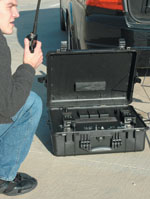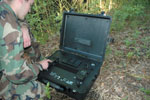Repeater Extends Handheld Radios' Reach
 |
| The MRC-200 Tactical Repeater System is designed to extend the range of modern multiband handheld radios. The repeater is manportable, but it also can be installed in vehicles for mobile operations. |
Both warfighters and their first responder counterparts depend on handheld radios to maintain small unit connectivity. These radios are lighter and less awkward than manpack systems, allowing more flexibility for users who must coordinate activities in adverse and chaotic situations. The disadvantage is that the range of handheld radios limits their effectiveness in areas with little or no infrastructure.
A new radio repeater designed for use by tactical forces, police and first responders may solve this dilemma by extending the range of modern multiband digital handheld radios. Developed by McDowell Research,
Very high frequency (VHF) systems have relied on repeaters for many years, explains Andrew Sheppard, a Rochester, New York-based radio systems expert familiar with the MRC- 200. The key advantage of a repeater system is that it greatly extends the range of handheld systems. “It effectively transforms them into a manpack. This means that operators such as special forces units can operate effectively on the ground where you don’t want the bulk of a manpack radio,” he says.
Older handheld radios such as those produced by Motorola and Racal Instruments have their own repeater systems, but the new generation of multiband handheld radios do not. “We have a situation where special forces and other user communities have upgraded from narrowband handheld radios to multiband radios with all their functionality and features. But when they want to use them in a repeater-based mode, there isn’t a supporting system. To date, users have had to use legacy repeater systems, which effectively takes them back to what they had in the first place,” Sheppard maintains.
Legacy repeaters operate on a fixed frequency, which means that their duplexers are tuned to a narrow frequency band to transmit and receive signals. Such restrictions can create difficulties, especially during joint expeditionary operations. Sheppard cites a personal experience from his service in the British army in which his unit deployed with preset systems only to discover that the French forces managing the operation already were using those frequencies. Because they were not allowed to use their original frequencies, the British forces had to borrow compatible equipment from other units. This type of frequency problem also extends to the new multiband radios because without a dedicated repeater system, they are restricted to using narrowband repeaters.
Because overlapping-frequency issues can create difficulties during operations, one requirement for the new system was the ability to operate across a spectrum of frequencies. But the duplexer front end of the repeater presented a design challenge because repeaters traditionally consist of two antennas in close proximity operating at the same frequency. With the antennas so near to each other, it is necessary to protect the receiving side of the system from the transmitter or outgoing transmissions will jam incoming signals. “The duplexer [on the MRC-200] does two things: It protects the co-location side by enabling a good transmit and receive path, and it enables the system to operate through a single antenna to do simultaneous receive and transmit,” he says.
Using a single antenna is important for tactical operations because operators do not have to worry about separating receive and transmit elements. Covert operations also benefit because units using vehicles can use one antenna instead of a cluster of multiple antennas.
Sheppard notes that McDowell worked with the end users to accommodate their spectrum requirements. The firm’s engineers designed a series of field-interchangeable duplexers. “Physically, they’re all the same size, shape and weight, and they snap in and out of the system according to which part of the spectrum you want to use,” he explains.
For example, a typical arrangement includes a duplexer operating in the upper VHF and ultrahigh frequency (UHF) bands and lower UHF spectrum bands. He notes that these areas cover three major band areas for users. Each duplexer is a broadband system with 8-megahertz receive and transmit windows split by a separation band. The increase in bandwidth allows users to move anywhere within the window to receive and transmit signals. “If you wanted to use a frequency in a certain part of the spectrum, and that frequency is in contention because it’s being used by someone else, you can go anywhere in that 8-megahertz band,” he says.
From a radio frequency standpoint, Sheppard describes the system as “radio-agnostic.” He notes that although it was designed to support the multiband inter/intra team radio (MBITR), the repeater can be modified for use with other types of handheld radios.
The MRC-200 is designed as a general purpose repeater. Weighing 50 pounds with batteries, the repeater fits in a standard travel case that meets commercial aircraft carry-on baggage requirements. The system normally uses lithium ion batteries, but other types of batteries also can be used.
The basic components of the repeater include a radio frequency element with the duplexer and a 20-watt multiband power amplifier. The MRC-200 has a universal power supply system for charging its batteries, and it can accept worldwide alternating current and direct current sources. The device can operate up to 24 hours on battery power.
The repeater has a platform mode that allows it to connect to a 12-volt power source. Sheppard explains that in this mode, the system can be placed covertly in a civilian vehicle and powered through the cigarette lighter. When the radio transmits, it pulls current from its batteries, and when it receives signals, it uses the current from the vehicle to charge the batteries. “That means we can put the system in a mobile role instead of trying to route cables through the engine compartment—which is going to take you a couple of hours to do,” he says.
 |
| The MRC-200 does not have an embedded security system. It relies on the cryptographic features of the handheld waveforms it is transmitting to maintain security. Because it lacks a built-in encryption system, the repeater can be left unattended without fear of compromising a mission if it is lost or captured. |
Because modern handheld radios use the continuously variable slope delta (CVSD) waveform, they can transmit data. Sheppard notes that the repeater can support asynchronous data transfers up to 16 kilobits per second. However, he explains that this poses difficulties for data transmissions requiring acknowledgment because there is a time out in the transmission.
For example, the system can transmit the Harris Corporation’s imagery waveform. While the repeater can send the signal out, the radios cannot acknowledge the data because of the quarter-second delay going through the repeater. “It will work with certain types of data messaging and techniques, but it’s really an area that is going to be determined by the application,” he says.
Sheppard notes that the CVSD waveform is the de facto standard for digital voice communications, making the repeater interoperable with all waveforms used by digital tactical radios. Major handheld manufacturers such as Tadiran, Thales and Harris all use CVSD waveforms. He explains that digital voice is desired for the repeater because commercial analog radios would otherwise interfere with its operation.
The MRC-200 was officially released in June. However, Sheppard notes that a two-case variant of the system was sold earlier this year to a customer in the
Web Resource
McDowell Research: www.mcdowellresearch.com




Comments